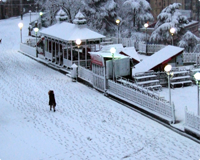Shimla
 Height : Most of the town lies between 2,100 M and 2,300 M.
Height : Most of the town lies between 2,100 M and 2,300 M.
Languages Spoken : Hindi, English, Punjabi and Pahari.
Religion : Hindu, Sikh, Muslim and Christian.
Medical Facilities : Good.
History seems to have been the mortar for every brick and stone that has built Shimla. As the summer capital of British India for well over a century it was the seat of one of the most powerful governments in the world. From its cedar-shaded heights, one fifth of the human race was ruled and the decisions made those decades ago affect our lives to the present day. The town of Shimla rose in the nineteenth century when the Gurkha Wars came to an end in 1815-16 and the victorious British decided to retain certain pockets as military outposts and sanitaria. In 1822 the most rigorous of dandies and the greatest of sticklers for form Captain Charles Pratt Kennedy, Political Agent to the Hill States directed that a house be built for him at the village whose name is variously reported as Sheyamalaya Shumlah, Shimlu and Shemlah. Kennedy House led the vanguard of the hundred-odd houses that were to scatter themselves by 1841 over every level or gently inclining space. Lured by the climate and terrain scores of European invalids began moving to the station and the only stipulation of the local chief who owned the land was that no tree be cut or cattle slaughtered.
In 1864 the Viceroy, John Lawrence anointed Shimla - then spelt Simla, as the summer capital of British India. With Lawrence came the Viceroy Council, the Imperial Secretariat, representatives of the Indian princes and foreign envoys. As the town grew to become the workshop of the Empire, an awed visitor observed, every pigeonhole cradled an embryo of a war or death. Despite the fact that up to the time of Indian independence in 1947, Shimla officially remained only the summer capital, yet the Government spent more time in these hills than at the actual capital Calcutta and later New Delhi. As the bearer of the Viceregal sceptre this tiny pocket became the cynosure of British Empire. Imperial grandeur, and all the panoply and trappings of power came along for the ride. And there was a popular local saying that went, "You cannot sleep the nights in Simla for the sound of grinding axes". A social whirl of parties, gymkhanas, balls, fancy fairs and affaires du Coeur ensured that a heady mixture of scandal and intrigue constantly wafted through the town.
Quite inevitably the freedom movement had a close connection with Shimla. Ornithologist and former Civil Servant, Allan Octavian Hume created the Indian National Congress which spearheaded the struggle while living in the town. Stalwarts like Mahatma Gandhi, Pandit Nehru, C. Rajagopalachari, Pandit Madan Mohan Malviya and Maulana Azad regularly visited Shimla. Major events that took place in the town were the Simla Conference in 1942, the deliberations of the Cabinet on and finally the decision to partition India.
Plan Your Sightseeing :
If you are fond of walking, Shimla will unfold parts that remain hidden to vehicles. Combinations by car and then on foot are possible in several areas. It is suggested that you take a direction for the day and cover the places of interest. The area around the Institute of Advanced Study has several walks. Combine these with visit to the State Museum and expand if you will towards Kamna Devi. Tara Devi and Sankat Mochan can be linked with a short train ride to Tara Devi station. The Himalayan Queen that leaves Shimla at 10.15 am is recommended. Jakhoo can be combined with a stroll and shopping on the Mall and in Lakkar Bazaar. The Lower Bazaar that runs parallel to the Mall at a lower level has the flavour of a typical Indian market place. Trinkets that can be purchased here include silver jewellery. You can also walk towards Chotta Shimla and Raj Bhavan the residence of the state Governor. The recently created rooms of Himachal Darshan offer a glimpse of the various district in the state. Jakhoo has several paths that criss-cross the hill a good walk is along the old Five Benches Road near the microwaves link tower. The Bharari spur also has many walks that can be done in a few hours or carried over the day
Special Interest :
- Nature
- Colonial Architecture
- Shopping











 Manali
Manali

